

Did you know that the Independence Palace is one of the most unique and famous architectural structures in Ho Chi Minh City? This site has witnessed many important milestones in the national struggle for independence by previous generations. Join BDATrip to explore this famous location through the article below!
The Independence Palace, an architectural masterpiece with a deep imprint of Vietnam's history, has seen many changes over the periods. Since its completion in 1871 under the name Norodom Palace, the palace has gone through various names, reflecting its changing roles and significance.

From 1871 to 1887, it was known as the Governor's Palace of Cochinchina, symbolizing the power of the governing governor. Then, from 1887 to 1945, it was known as the Palace of the Governor-General, highlighting the absolute power during the colonial period.
In 1955, President Ngo Dinh Diem officially renamed it the Independence Palace, a name that remains to this day. Finally, in 1976, the palace was honored as a National Cultural Historical Site, affirming its special value in Vietnam's history.
Adult tickets to the Independence Palace cost 40,000 VND and 20,000 VND for children. Tickets can be purchased directly at the ticket counter at the main gate or through famous travel websites like BDATrip, saving you time and money.
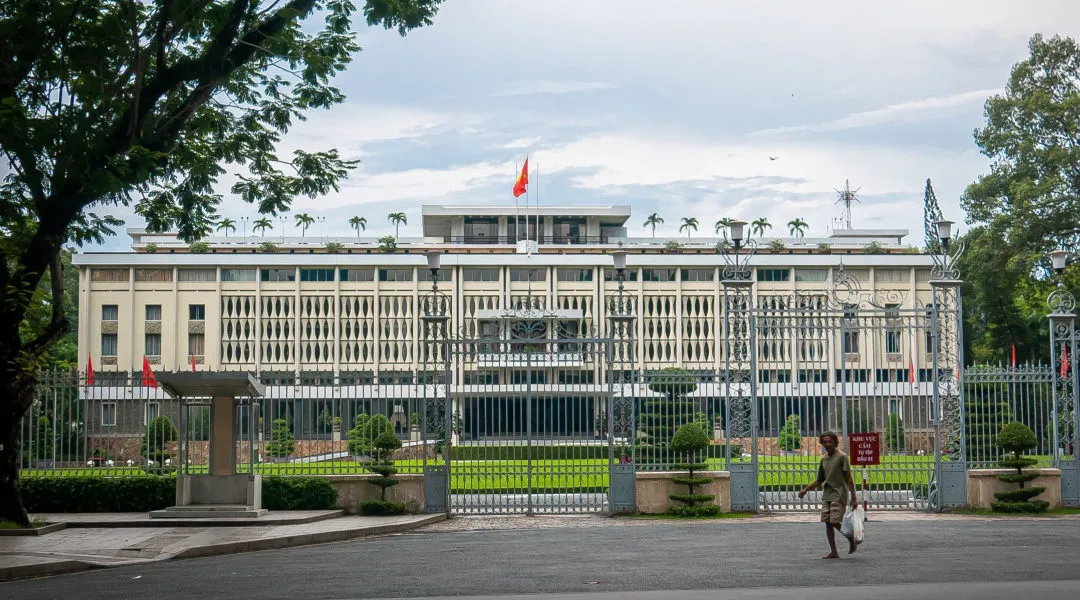
The Palace is open daily, including holidays and Sundays, from 7:30 AM to 11 AM and from 1 PM to 4 PM. Arriving early helps visitors avoid crowds and enjoy the tour more comfortably.
The Independence Palace is located at 135 Nam Ky Khoi Nghia, Ben Thanh Ward, District 1 of Ho Chi Minh City, easily accessible by various means of transportation:
- Bus: Choose from routes 03, 04, 18, 19, 27, 29, 30, 34, 36, 39, 42, 46, 48, 50, 52, 53, 56, 59, 68, 72, 74, 93, 109, 152, or 157 and get off at a station near the palace.
- Motorbike: Rent a motorbike from rental points in Ho Chi Minh City and drive to the location, with parking costing 5,000 VND/bike at the secondary gate.
- Taxi: Choose a taxi from Mai Linh, Vinasun, Grab, or Gojek, with a fare of about 15,000 VND/km.
- Tourist Bus: Book a Saigon tour through BDATrip, with prices depending on the type of tour and duration.
With over 150 years of history, the Palace has been a witness to many memorable events in Vietnam's history. Starting in 1868, the French colonialists built the Norodom Palace, later completed in 1871 by architect Achille-Antoine Hermitte. When France was defeated at Dien Bien Phu in 1954, the Saigon government took over and renamed it the Independence Palace.
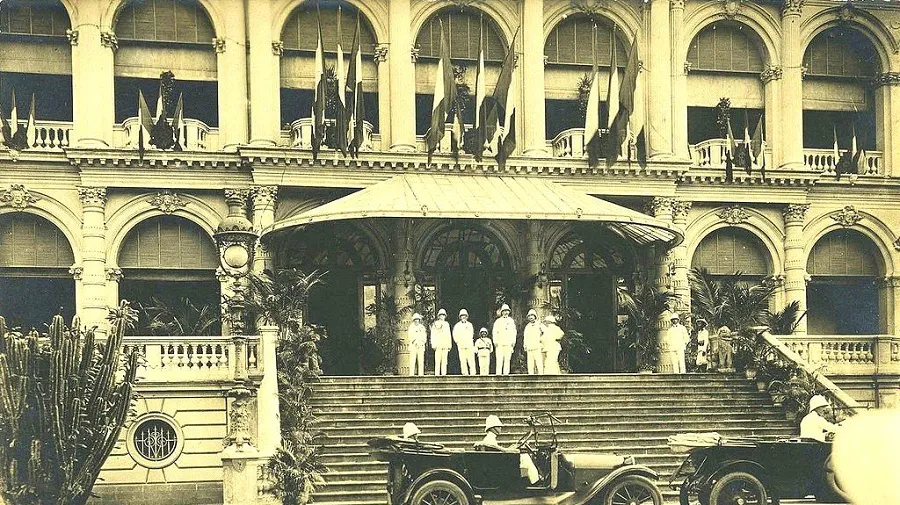
A crucial turning point occurred in 1955 when President Ngo Dinh Diem took power, overthrowing State President Bao Dai and establishing the Republic of Vietnam government, making it the administrative center and his residence. However, in 1962, the palace was heavily damaged by a bombing and was rebuilt by architect Ngo Viet Thu.
In the following years, especially in 1963, a military coup led to the assassination of Ngo Dinh Diem, turning the palace into the headquarters of interim governments and subsequent presidents of the Republic of Vietnam. A pivotal moment in the palace's history was in 1975 when tanks of the South Vietnamese Liberation Army entered, symbolizing the country's unification.
Later, in 1976, the palace was recognized as a national cultural historical site, welcoming visitors and becoming a symbol of Vietnam's history and culture.
The architecture of the Independence Palace stands out with a rectangular shape, each side exuding elegance and solemnity. Standing 26.5 meters high, 80 meters long, and 40 meters wide, the palace includes two above-ground floors and a deep basement, all constructed with solid reinforced concrete. The choice of white as the dominant color not only brings elegance but also reflects power and stature.
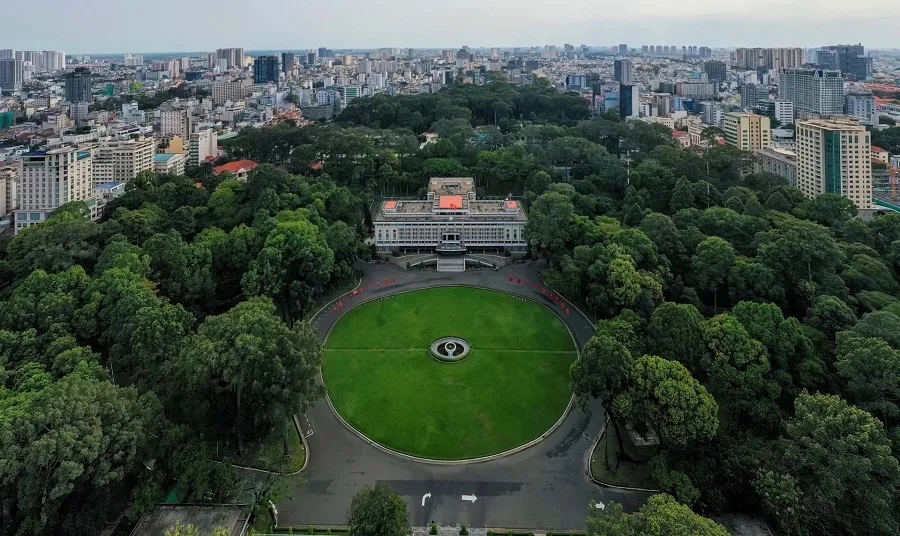
The three main doors on the facade of the palace are clearly divided by function: the central door, large and magnificent, reserved for welcoming distinguished guests; the two side doors, smaller and more discreet, for employees
and security. Above the palace's roof is a small tower, delicately designed, housing communication and positioning equipment.
The open space in front of the palace overlooks a large square, where the President's statue is located. A towering 35-meter flagpole is also erected here, highlighting the historical importance and significance of this place in the heart of Saigon.
The Independence Palace is surrounded by a large garden, not only diverse in trees and flowers but also featuring fountains and various auxiliary constructions.
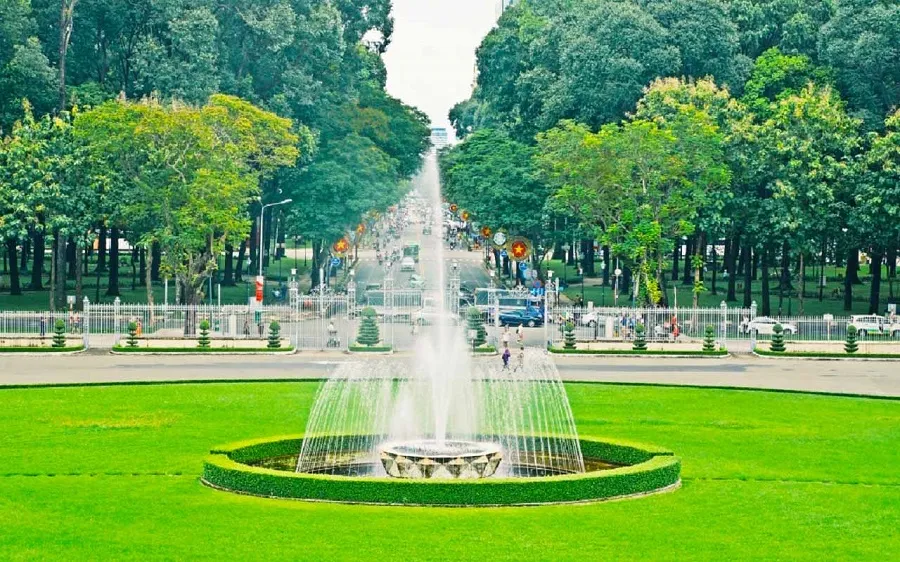
The underground bunker, discreetly located underground, once served as a hideout for the President and staff in case of war emergencies. It is fully equipped with bedrooms, dining rooms, medical rooms, and war command rooms. Next is the garage, displaying an impressive collection of antique cars and tanks, ranging from automobiles, motorbikes, bicycles to historic tanks.
The Palace's airport area showcases combat aircraft, transport planes, and helicopters, reflecting the history of Vietnam's military aviation. The tennis court, situated within the premises, serves as a recreational space for the President and guests, complete with tennis courts, rackets, and balls. Finally, the bird sanctuary is home to beautiful and rare birds, creating a vivid picture with their singing echoing throughout the garden.
The permanent area of the Independence Palace is a "living testament," preserving the space and furnishings as they were before 1975. Exploring this area, you will immerse yourself in the daily life and work of the President and his staff, as well as witness the imprint of important historical events that took place here.
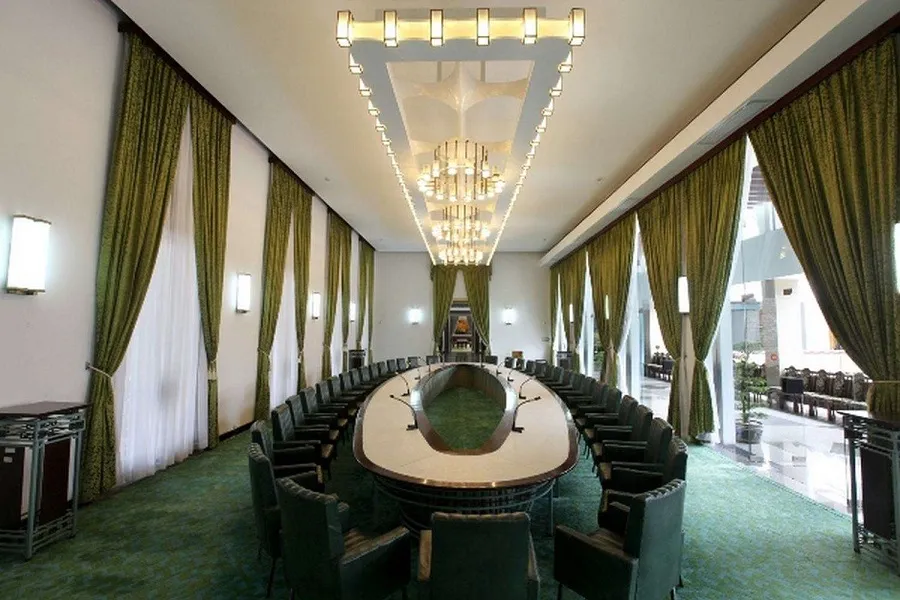
The permanent area consists of various functional rooms, creating a panoramic view of life and work in the Palace. The living room with polite and elegant furnishings, the office filled with necessary office items, the personal bedroom with a strong personal imprint, and the dining room where important banquets took place. The meeting room and war room are critical spaces for decision-making and directing, while the entertainment room reflects the lifestyle and preferences of historical figures.
Additionally, the bunker holds secrets and strategies during difficult times, the garage and airport display transportation and aircraft, evidencing the nation's development. The tennis court and bird sanctuary add a peaceful atmosphere, where the President and guests can relax and enjoy private moments.
In the thematic area, visitors will explore a series of rich themes related to the history, culture, and art of the palace through various vivid presentation forms such as information boards, photos, maps, models, videos, audio, and illustrative artifacts.
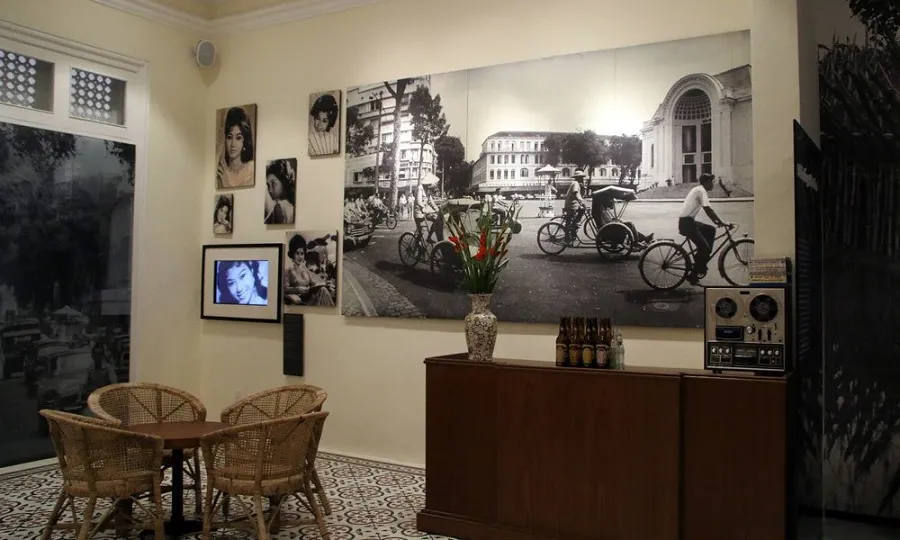
The first theme, "The History of Building the Independence Palace," opens the story of the construction, destruction, and recreation of the Palace from 1868 to 1966, along with introducing the architects and contractors who contributed to this project. Next, "The History of Activities" takes viewers through political, military, diplomatic, cultural, and social events from 1954 to 1975, along with historical figures who left their mark here.
Another important part is "The History of the Events of April 30, 1975," recreating the day the South Vietnamese Liberation Army captured the palace, an event marking the country's unification day, along with its witnesses and long-term impact. Finally, "The History of Preservation and Promotion" describes efforts to preserve and honor the historical, cultural, and artistic values of the Palace from 1976 to the present, including tourism and educational activities taking place here.
The supplementary area at the Independence Palace features movie theaters with a capacity of 50 to 100 people ready to serve you with high-quality documentary films, providing an in-depth view of the history, culture, and art related to the palace. Additionally, educational and entertainment game stalls offer a great opportunity for you to interact and learn more about Vietnam's history and culture in a fun and friendly atmosphere.
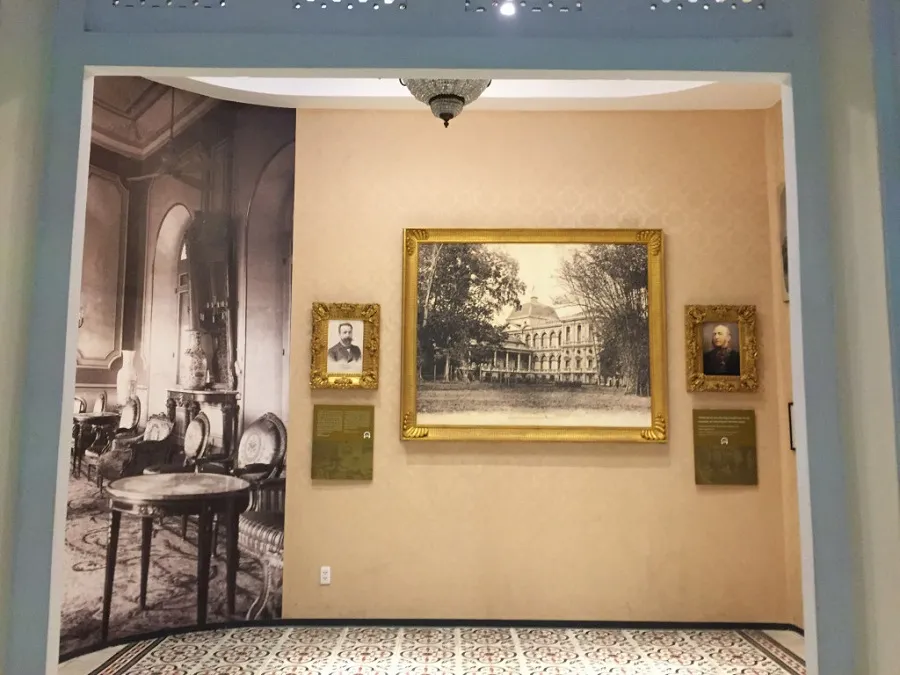
For those who want to experience Vietnamese culture authentically, the area for trying traditional and modern Vietnamese costumes is an ideal destination. Here, you can experiment and take photos with distinctive outfits. Finally, the souvenir photo area provides a great opportunity for you to capture memorable moments next to the palace's unique objects and landscapes.
When moving and touring at this location, you should adhere to the following regulations:
- Avoid carrying items that could be dangerous or troublesome, such as weapons, explosives, flammable and toxic substances, alcoholic beverages, cigarettes, and pets.
- Bags, backpacks, suitcases, and mobility aids such as strollers, wheelchairs, bicycles, and motorbikes are not allowed inside the palace. These items can be stored in the free storage area at the main gate.
- Do not run, play excessively, shout, sing, play loud music, lie down carelessly, climb, or vandalize. Maintain cleanliness, do not scribble or litter, eat, smoke, or drink alcohol within the palace grounds.
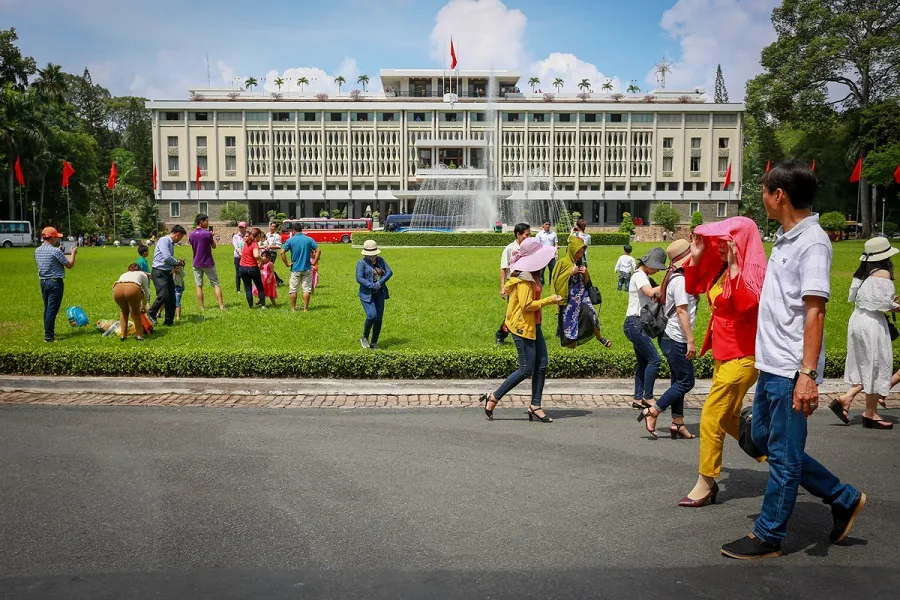
Furthermore, if visitors want to gain a deeper understanding of the history, culture, and art of the Independence Palace, it is recommended to hire a tour guide at the palace. The guide will take you around the various areas of the palace and explain the details of the exhibits.
To conveniently explore the Independence Palace and discover Saigon, visitors can consider the following accommodation options:
- The Reverie Saigon: Located in the central position of 22-36 Nguyen Hue, District 1, just 1 km away from the palace. The hotel offers a luxurious space with a swimming pool, spa, restaurant, gym, bar, and airport shuttle service. Prices range from 4 to 15 million VND/night, including breakfast and wifi.
- Park Hyatt Saigon: Situated at 2 Lam Son Square, District 1, about 1.2 km from the palace. Known for its swimming pool, spa, restaurant, gym, bar, and shuttle service. Classic rooms with pool or park balconies, and perfect amenities. Prices range from 3 to 10 million VND/night, including breakfast and wifi.
- Mai House Saigon: Located at 157 Nam Ky Khoi Nghia, District 3, just 500 m from the palace. Newly opened, with a swimming pool, spa, restaurant, gym, bar, and shuttle service. Modern rooms with city balconies, high-quality amenities. Prices range from 2 to 7 million VND/night, including breakfast and wifi.
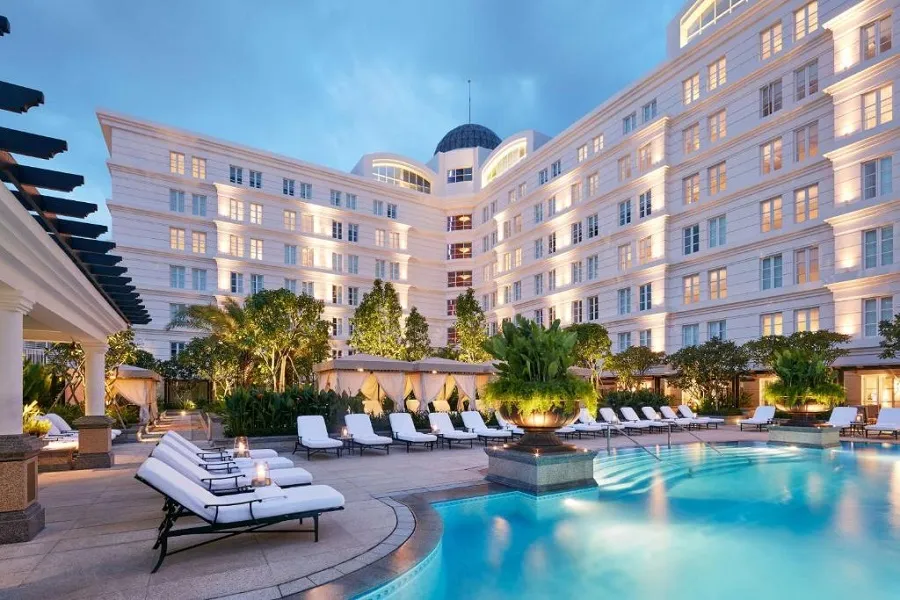
Enjoy a diverse culinary journey near the Independence Palace with the following dining spots:
- The Reverie Saigon Restaurant: At 22-36 Nguyen Hue, District 1, 1 km from the Palace. Features a luxurious space with dishes ranging from seafood to pizza and international options. A wide variety of drinks from wine to coffee. Prices: 200,000 - 1,000,000 VND/dish.
- Quan Khoai: Located at 3A Le Quy Don, District 3, 1.5 km from the Palace. Specializes in Central Vietnamese cuisine from banh xeo to bun thit nuong, at affordable prices. Prices: 20,000 - 50,000 VND/dish.
- Gao Restaurant: At 33 Nguyen Thi Minh Khai, District 1, 500 m from the Palace. Cozy with traditional Vietnamese dishes from salads to pho. Juices and coffee also available. Prices: 50,000 - 150,000 VND/dish.
- Tandem Cafe: At 18/13A Nguyen Thi Minh Khai, District 1, 200 m from the Palace. Quiet space, diverse coffee, and light snacks. Prices: 15,000 - 30,000 VND/dish.
- Beirut Restaurant - Villa & Pool: Located at 43 Tran Ngoc Dien, District 2, 7 km from the Palace. Arabic cuisine from hummus to kebabs, along with pool and spa amenities. Prices: 100,000 - 500,000 VND/dish.
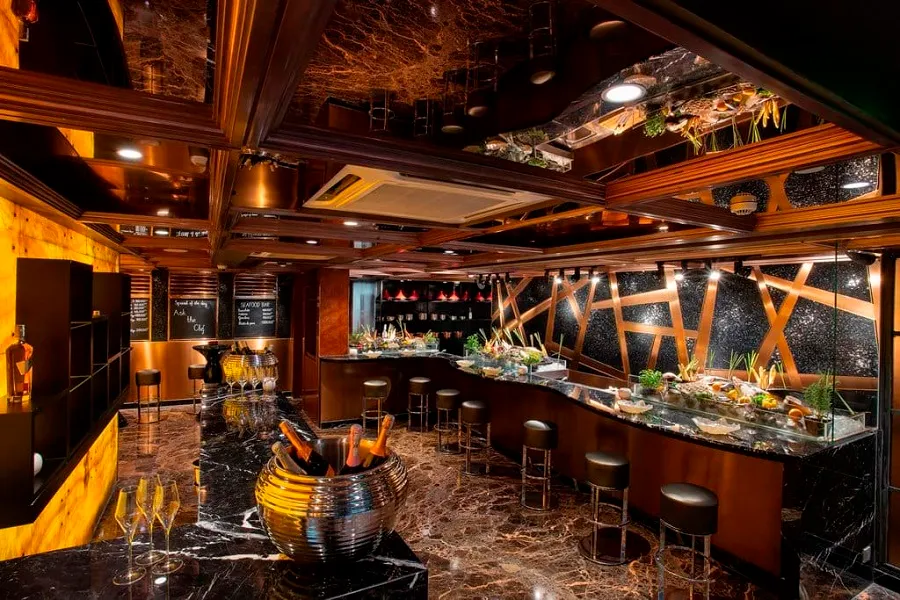
Independence Palace is not only a historical tourist destination, but also a gateway to explore Vietnam's rich culinary culture. Come to this attractive location as soon as possible to have a memorable travel experience!
Địa điểm du lịch gần Dinh Độc Lập:
Copyright © 2022 BDATrip.com | All rights reserved.